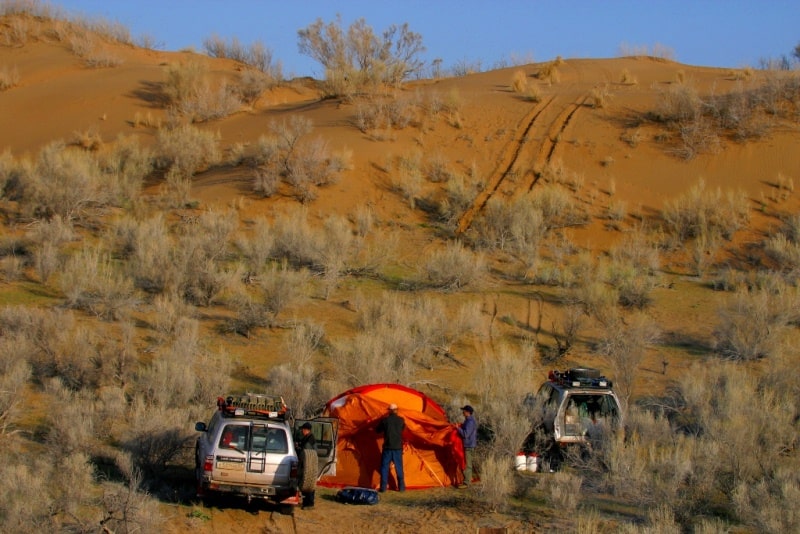You are here
Kyzyl Kum desert. Kazakhstan.

Hiking season in Kazakhstan.
“The state is a creation of nature and man is by nature a political animal”
Aristotle.
Go for a ride in Kazakhstan.
Flying the 1,250 kilometres between Kazakhstan two major cities, Almaty and Astana, one can gain an impression that much of the country is desert. The trackless stony desert south of Lake Balkhash is one of the Earth's true empty quarters.
At the same time it is not easy to draw a distinct line in Kazakhstan between desert, semi-desert and dry Steppeland, or between the different types of desert. Geographers have now formally classified as much as 1,240,000 square kilometres or 44 per cent of the country as being within 'desert ecological systems.
In fact, Kazakhstan contains three main deserts. The Kyzyl Kum (the Red Sands) desert lies to the south-east of the Aral Sea between the Syrdarya and Amudarya rivers and is shared with Uzbekistan. The Ustyurt desert occupies the area between the Aral Sea and the Caspian Sea.
The Betpak Dala desert is located in the area between the Aral Sea and Lake Balkhash. A primary feature of all Kazakhstan's deserts is their low precipitation which rarely exceeds 200 mm a year. In the northern part of the country of course, much of this falls as snow.
Most precipitation occurs in winter and spring. Mean temperatures range from -15°C January to +26°C in July. Kazakhstan's deserts have also been divided into four different soil types by the National Geographical Society.
These are clay deserts characterised by a brief flowering period in spring before being dried out by the summer sun and the salt flats, which contain salt-tolerant plants and salt lakes. There are stony deserts, most of which are covered in gravel, and sandy deserts which are found mainly in southern Kazakhstan.
Each of these desert categories has its own particular physical and ecological characteristics. One peculiar feature of the Betpak Dala desert between Almaty and Lake Balkhash are the so-called 'singing sands' which are giant barkhans of up to 150 metres in height which can produce quite a musical squeak when trodden upon.
The Kyzyl Kum desert of southern Kazakhstan tends to be sandy rather than stony, and this has influenced the ecology. It is characterised by white (Haloxylon persicum) and black saxaul (Haloxylon aphyllum) bushes and trees, also known as 'desert forest'.
In spring after rain the desert floor is often covered with wild tulips, giant brome, sagebrush, bindweed and wild stocks. Sandy acacia (Ammodendron conollyi) grows on the sand dunes themselves. It is said that in recent years saxaul trees have been over-exploited for fuelwood and that they have been replaced by desert moss which has little if any nutritional value.
Many of the mammals of Kazakhstan's deserts are endemic. These include species of jerboa, dormice and the Pallas cat. Kazakhstan's endemic cheetah is now extinct in the country itself. Other common desert mammals include species of hedgehog, hares and small rodents like gerbils and jerboas.
Numerous mammalian species like honey badgers, sand lynxes, sand cats, polecats and gazelles are threatened with extinction. The special nature of deserts encourages the evolution of endemic species and many of the reptiles of Kazakhstan's deserts are indeed unique to the region.
They include toads, lizards (including the giant grey monitor lizard), gekkoes and various species of snake, including the now rare Central Asian cobra (Naja naja oxiana). The desert lark (Ammomanes deserti) is one of the most enduring symbols of the deserts of Kazakhstan.
Other common Steppe and desert birds are wheatears, desert ravens, desert shrikes and desert warblers. Some of the rarer (and larger) species of bird, for example the houbara bustard (Chlamyodits undulata), the Asian desert sparrow (Passer zarudnyi), the golden eagle (Aquila chrysaetus), the short-toed eagle (Circaetus gallicus), the Steppe eagle, (Aquila rapax), the Egyptian vulture (Neophron percnopterus), and the saker falcon (Falco cherrug) have become endangered through injudicious hunting.
How far the nature of deserts in Kazakhstan are a result of climatic conditions and how far they result from human activity (nomadic pastoralism) is uncertain. However it seems most probable the climatic factors are more-important and that the pastoralist lifestyle of the Kazakhs was in fact a direct response to climatic conditions.
Recent research has postulated that large areas of the desert rangelands in Kazakhstan were degraded by over-grazing in the Soviet period. But in certain areas the degree of degradation has been exaggerated.
The economic and institutional changes which Independence brought to Kazakhstan at the beginning of the 1990s does seem to have had a number of impacts on Kazakhstan's deserts. After Independence it became more difficult for local authorities to manage the animal and vegetation resources in the deserts because of lack of transport and facilities.
Poaching and illegal hunting increased and took several years to control. It also seems clear that the livestock population of Kazakhstan fell sharply after independence for many reasons and that it will take many years to recover.
This has meant that large areas of marginal and threatened desert lands have been nutilised for many years. Pastures and razing areas have been left fallow and so recovered their previous productivity. This augurs well for the future productivity and wellbeing of the lands of Kazakhstan.

Authority:
Book “Kazakhstan. Coming of Age”. Michael Fergus, Janar Jandosova.
Photos
Alexander Petrov.







